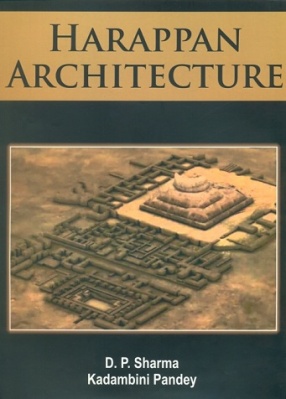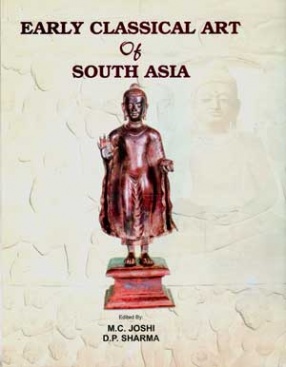
D P Sharma

Showing all 23 books
















Mauryan Art (c. 321-185 B.C.) is the formative stage of early Indian Art and its roots are present in Harappan Art (c. 2700-2000 B.C.) of north-western part of South Asia. A few motifs of the Mauryan art, like the back-to-back Lions, Bull, Linga & Arghya, Trisula, Nandipada, Lotus, Srivatsa, Kalash, Chiti (Ratha chiti), monolithic polished pillar and rock-cut architecture are found in the lower tradition of Harappan art which were developed into higher ...

The stone age in south Asia is 48th book of Dr. D.P. Sharma. This activity book includes origin of Man, Lower Palaeolithic (4.4. Mya to .125 Mya), beginning of Chalcolithic (5500-4000 B.C.). In last there are questionnaire, suggested reading list of publications of authors and also chronology of South Asian region. This pictorial book is for Archaeologists, Anthropologist and Indian Civil Service Student.
First Homonoid Sahelenthropus appeared in chad (Africa) ...

This book "Potteries of South And East Asia through the Age's in three volume are 50th, 51. and 52nd" book, of Dr. D.P. Sharma. These volumes cover oldest handmade potteries of Mesolithic Neolithic transition to beginning of early Medievel Period. In East Asia earliest Handmade potteries begin between 21000-15000 B.C, The first volumes cover, late Mesolithic to Neolithic, Early Harappan, Mature Harappan period potteries and has 37 papers of scholar like ...




This book “The Roots of South Asian Art” is a joint work of D.P. Sharma and Madhuri Sharma. The book covers Art History of South Asia from upper Palaeolithic to Early historic period. Roots of South Asian Art exist in lower traditions of South Asia since Harappan age (circa 2700-2000 B.C.) and these roots developed in higher traditions of Art from 3rd c.B.C. onwards. Mother Goddess worship began during circa 20000 B.P. and developed during Harappan, ...

Today as we freely move around in our country without anyone questioning or imposing any kinds of restrictions on us we feel satisfied and contended. But this satisfaction is due to the efforts taken by our freedom fighters to free our country from the British rule. Its because of our freedom fighters that today we are enjoying are freedom. Their Satyagrahas, sacrifices and tortures have resulted in the freedom that we enjoy today in our motherland India.
India ...

This book "A Study of Coins" covers Numismatic studies of South Asia from earliest timeto modern period. The Ancient South Asian coinages have a very long and varied historical tradition providing a rich souce of information. This part on Punch marked to Gupta Period will serve the needs of students and academicians, who want to study the coins from ancient to modern times. This is the first kind to study which will highlights from the first Punch ...


The present volume 'Early Classical Art of South Asia' is edited by Prof. M.C. Joshi and Dr. D.P. Sharma. The period of Gupta dynasty begins around 319 A.D. ends up to 578 A.D. The art Gupta periods has often been referred to us classical art of early South Asia. The art of Gupta period was characterized by a sensitivity modeled body from a severity of expansion and dominant spiritual purpose.During Gupta Age there was all-round development particularly ...

ENCYCLOPAEDIA OF INDIAN ARCHITECTURE: HINDU, BUDDHIST, JAIN & ISLAMIC: HINDU: This volume of the book entitled 'Encyclopaedia of Indian Architecture' is devoted to the study of Hindu architecture. It has fourty-six chapters. The Chapters in this volume deal with the origin of architecture in India, the architecture of Rgvedic period, the architecture in the later Vedas and Brahmanas, the Vastuvidya in Sutra literature, the settlement patterns, urban planning ...

Panorama of Harappan Civilization deals with the introduction of Harappan Civilization, Harappan Art, Seals, Ceramics and Jewellery. The authors prefer the name of Harappan Civilization to Indus or Indus-Saraswati Civilization. An unique contribution in this book is the identification of the inscribed double headed terracotta of Siva from Kalibangan which has three Harappan signs in Proto-Brahmi Script and the authors have read these three signs as Sivam. The ...

The book deals perceptively and dispassionately with very old problem in a very new context: human response to human brutality. Terrorism is as old as human civilization. Throughout our historical record of over thousands year, terrorism in various forms, has been common, often destructive, varied in content yet similar in basic themes. To threaten, injure, or kill innocent bystanders in a circumstance of political, social or ideological compulsion is an ancient ...

According to a scholar the Harappan Civilization is the gift of two rivers - the Indus and Sarasvati whose tributaries had played a dominant and decisive role in the origin of this bronze civilization. As of now around 2658 Harappan and its associated sites have been reported, of which 1058 sites are located in the dried-up bank of the Sarasvati river. The Sarasvati was a mighty river between ca. 5000 and 1800 B.C. Around ca. 1800 B.C., due to neo-tectonic ...

The book Harappan Art deals with the art object in stone, metal, glyptic art, terracotta, jewellery and ceramics. This book is descriptive catalogue data of 200 Harappan objects. The first chapter is on includes nomenclature, discovery, extent, chronology, migration, Harappan collection in National Museum, settlement pattern, social stratification, art, craft, seal, religion, burial and decline. The second chapter is on harappan stone image and here we have ...

In the next two decades, population of India is likely to cross I.4 billion mark. With additional burden on food grains consumption from demographic shift from rural to urban centers and change in food habits, India need to produce about 325 million tons of food grains by 2007. since the competing demands from other sectors of economy for the inelastic land resource are multiplying fast, the best agricultural lands are being encroached upon by these ...

This volume of the work entitled 'Encyclopaedia of Indian Architecture' Is devoted to the study of Jain architecture. It has eighteen chapters. discuss Iain Rock-cut caves from Pabhosa, Khandagiri and Udayagiri, Jain caves at Ellora, Jain caves of Maharashtra, Jain caves at Dharasiva, the Jabareshwar temple at Phaltan, Jain Architecture of south India, Jain temples of the Pallavas and the Cholas in Tamilnadu, the Parsvanatha Nagraja temple of ...

This volume of the work entitled 'Encyclopaedia of Indian Architecture' is devoted to the study of Islamic architecture. It has thirty nine chapters. The chapters discuss The Sources of Islamic Architecture in India. The Delhi or Islamic Architecture in India. The Delhi or Imperial Style: Its Beginnings under the slave Dynasty, The Thirteenth century Mosques at deli and Ajmer -The Qutb Minar, The Delhi or Imperial style: The Buldings of the Khalji Dynasty, The ...

This volume of the book entitled 'Encyclopaedia of Indian Architecture' is devoted to the study of Hindu architecture. It has fourty-six chapters. The Chapters in this volume deal with the origin of architecture in India, the architecture of Rgvedic period, the architecture in the later Vedas and Brahmanas, the Vastuvidya in Sutra literature, the settlement patterns, urban planning and architecture of Harappans, the residential architecture of Harappans, ...

This volume of the work entitled 'Encyclopedia of Indian Architecture' is devoted to the study of Buddhist architecture. It has twenty four chapters. The chapters discuss Buildings during the Rule of the Early Mauryan Dynasty (c. 400 B.C.): Wooden Origins, Asoka and the Beginnings of the Buddhist School (c.250 B.C.) The Stupa and its Symbolism, Architecture of Sungas, Buddhist Rock -Cut Architecture, Rock-Cut Architecture of Hinayana 2nd Century B.C., Buddhist ...

Garuda in Asian Art is a joint work of E. Yamamoto and D.P. Sharma. This pictorial book deals with the introduction, deals with the introduction, Iconography of Garuda, Garuda in inscriptions in Ancient literature, Garuda pillars, Garuda in ritual Altars, Garuda in Art and Motif, Garuda on Coins and Seals. Garuda in Bronzes and Garuda in Tantra. This also deals with Garuda or Eagle abroad, Garuda in India, Nepal and Bhutan and Garuda in living ...
